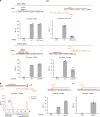CRISPR GUARD protects off-target sites from Cas9 nuclease activity using short guide RNAs
- PMID: 32807781
- PMCID: PMC7431537
- DOI: 10.1038/s41467-020-17952-5
CRISPR GUARD protects off-target sites from Cas9 nuclease activity using short guide RNAs
Abstract
Precise genome editing using CRISPR-Cas9 is a promising therapeutic avenue for genetic diseases, although off-target editing remains a significant safety concern. Guide RNAs shorter than 16 nucleotides in length effectively recruit Cas9 to complementary sites in the genome but do not permit Cas9 nuclease activity. Here we describe CRISPR Guide RNA Assisted Reduction of Damage (CRISPR GUARD) as a method for protecting off-targets sites by co-delivery of short guide RNAs directed against off-target loci by competition with the on-target guide RNA. CRISPR GUARD reduces off-target mutagenesis while retaining on-target editing efficiencies with Cas9 and base editor. However, we discover that short guide RNAs can also support base editing if they contain cytosines within the deaminase activity window. We explore design rules and the universality of this method through in vitro studies and high-throughput screening, revealing CRISPR GUARD as a rapidly implementable strategy to improve the specificity of genome editing for most genomic loci. Finally, we create an online tool for CRISPR GUARD design.
Conflict of interest statement
The authors declare no competing interests.
Figures






Similar articles
-
Optimization of genome editing through CRISPR-Cas9 engineering.Bioengineered. 2016 Apr;7(3):166-74. doi: 10.1080/21655979.2016.1189039. Bioengineered. 2016. PMID: 27340770 Free PMC article. Review.
-
Doxycycline-Dependent Self-Inactivation of CRISPR-Cas9 to Temporally Regulate On- and Off-Target Editing.Mol Ther. 2020 Jan 8;28(1):29-41. doi: 10.1016/j.ymthe.2019.09.006. Epub 2019 Sep 12. Mol Ther. 2020. PMID: 31601489 Free PMC article.
-
Postnatal Cardiac Gene Editing Using CRISPR/Cas9 With AAV9-Mediated Delivery of Short Guide RNAs Results in Mosaic Gene Disruption.Circ Res. 2017 Oct 27;121(10):1168-1181. doi: 10.1161/CIRCRESAHA.116.310370. Epub 2017 Aug 29. Circ Res. 2017. PMID: 28851809
-
Targeted genome editing in human cells using CRISPR/Cas nucleases and truncated guide RNAs.Methods Enzymol. 2014;546:21-45. doi: 10.1016/B978-0-12-801185-0.00002-7. Methods Enzymol. 2014. PMID: 25398334
-
Engineering guide RNA to reduce the off-target effects of CRISPR.J Genet Genomics. 2019 Nov 20;46(11):523-529. doi: 10.1016/j.jgg.2019.11.003. Epub 2019 Nov 23. J Genet Genomics. 2019. PMID: 31902584 Review.
Cited by
-
Effective therapies for sickle cell disease: are we there yet?Trends Genet. 2022 Dec;38(12):1284-1298. doi: 10.1016/j.tig.2022.07.003. Epub 2022 Aug 4. Trends Genet. 2022. PMID: 35934593 Free PMC article. Review.
-
Induced Pluripotent Stem Cells (iPSCs) and Gene Therapy: A New Era for the Treatment of Neurological Diseases.Int J Mol Sci. 2021 Dec 20;22(24):13674. doi: 10.3390/ijms222413674. Int J Mol Sci. 2021. PMID: 34948465 Free PMC article. Review.
-
Non-homologous end-joining-deficient filamentous fungal strains mitigate the impact of off-target mutations during the application of CRISPR/Cas9.mBio. 2023 Aug 31;14(4):e0066823. doi: 10.1128/mbio.00668-23. Epub 2023 Jul 24. mBio. 2023. PMID: 37486124 Free PMC article.
-
To Cut or not to Cut: Next-generation Genome Editors for Precision Genome Engineering.Curr Opin Biomed Eng. 2023 Dec;28:100489. doi: 10.1016/j.cobme.2023.100489. Epub 2023 Jul 7. Curr Opin Biomed Eng. 2023. PMID: 37593347 Free PMC article.
-
Assessing and advancing the safety of CRISPR-Cas tools: from DNA to RNA editing.Nat Commun. 2023 Jan 13;14(1):212. doi: 10.1038/s41467-023-35886-6. Nat Commun. 2023. PMID: 36639728 Free PMC article. Review.
References
Publication types
MeSH terms
Substances
Grants and funding
LinkOut - more resources
Full Text Sources
Other Literature Sources

